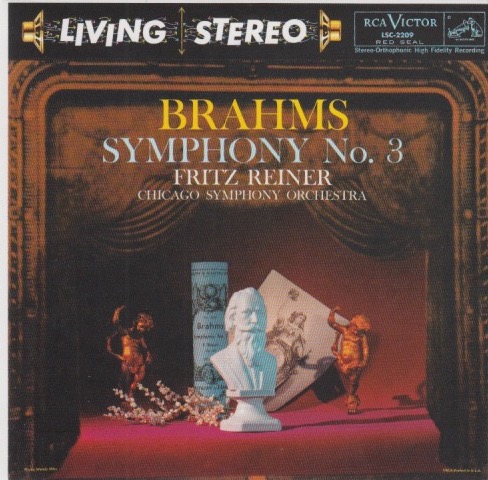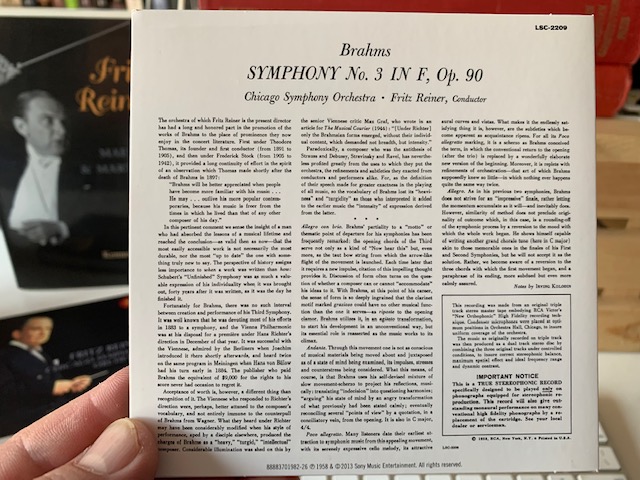
Brahms has never been one of my favorites, even though I have his complete works on the Brilliant Classics label – which is one of my favorites.
Brilliant Classics offers very high quality Classical recordings at very inexpensive prices.
Other labels – DG, Warner Classics, RCA Victor, the former EMI and Phillips, etc. – may have a more prestigious reputation for Classical music. But, for my money, Brilliant Classics editions are the way to go.
That stated, this Brahms Symphony is not a Brilliant Classics edition. It’s from the Fritz Reiner Chicago Symphony The Complete RCA Album Collection edition.
Yes, it’s an RCA Living Stereo recording. And, yes, the Reiner box set cost more than my first car.
But for all the enjoyment I’m deriving from listening to Brahms at the moment, I would have been better off hearing it from my Brilliant Classics edition, which I purchased for $59.56 on July 9, 2014.

Be that as it may, here I sit in my library, a fierce ninja watching over me, and my Abbey of Gethsemani mug beside me, filled with a new coffee blend my wife’s aunt just gave us: Our Family Caramel Cream coffee with a dash of International Delight Southern Butter Pecan creamer in it.

It’s a little too sweet for my tastes. But no one can argue that it’s not smooth. Man, is it smooth.
Much like what I’m listening to, in fact.
(How’s that for a segue?)
The Objective Stuff
According to its entry on Wikipedia, Brahms Symphony No. 3 in F, Op. 90,
…was written in the summer of 1883 at Wiesbaden, nearly six years after he completed his Symphony No. 2. In the interim Brahms had written some of his greatest works, including the Violin Concerto, two overtures (Tragic Overture and Academic Festival Overture), and Piano Concerto No. 2.
The premiere performance was given on 2 December 1883 by the Vienna Philharmonic Orchestra, under the direction of Hans Richter. It is the shortest of Brahms’ four symphonies; a typical performance lasts between 35 and 40 minutes.
After each performance, Brahms polished his score further, until it was published in May 1884.
By 1877, Johannes Brahms had completed his first two symphonies: The First Symphony in C Minor (Op. 68) was the product of a famously long gestation; its initial drafts dated to as early as 1862. The D Major Second Symphony followed barely 12 months after the First, and the next few years saw Brahms’ creative peak, during which he created “a series of large-scale masterpieces with fluency and ease.”
Among these masterpieces were Brahms’ Violin Concerto (1878/79) and Second (B♭ major) Piano Concerto (1881), the two symphonic overtures, two large collections of songs (lieder) and duets, several major piano pieces including the third and fourth sets of Hungarian Dances (1879), and three important chamber works, including the ‘lyrical’ and highly popular G major Violin Sonata (1879).
By 1883, Brahms’ attention had returned to the symphony, and he spent the summer of that year at Wiesbaden composing a new F major symphony. In October, he played the first and last movements (on piano) for Antonín Dvořák, who remarked to Nikolaus Simrock: “I say without exaggerating that this work surpasses his first two symphonies; if not, perhaps, in grandeur and powerful conception—then certainly in—beauty.”
Interesting.
Brahms, who died when he was 64, was 50 when he wrote this symphony. It was recorded on December 14, 1957, at Orchestra Hall, Chicago. Reiner was about 69 when he conducted it.
This symphony is not the only composition on the album.
The fifth track is called The Tragic Overture, Op. 81.
From its entry on Wikipedia,
The Tragic Overture, Op. 81, is a concert overture for orchestra written by Johannes Brahms during the summer of 1880. It premiered, under Hans Richter, on 26 December 1880 in Vienna. Eight days later, it was repeated at the University of Breslau on a program with the premiere of the Academic Festival Overture. Most performances last between twelve and fifteen minutes.
Brahms chose the title “tragic” to emphasize the turbulent, tormented character of the piece, in essence a free-standing symphonic movement, in contrast to the mirthful ebullience of a companion piece he wrote the same year, the Academic Festival Overture. Despite its name, the Tragic Overture does not follow any specific dramatic program. Brahms summed up the effective difference in character between the two overtures when he declared “one laughs while the other cries.”
Brahms was 47 when he wrote The Tragic Overture.
The Subjective Stuff
Recording quality: 4.5
Overall musicianship: 5
CD booklet notes: 2
CD “album cover” information: 4.5
How does this make me feel: 4

I’m shocked!
I actually enjoyed this symphony from Brahms!
When I ceased to expect that it would blow me away, that it would be full of intriguing, gut-wrenching melodies and bold, stirring contrasts between soft and loud, and I just let the music wash over me, I found myself getting lost in it. In addition to the music, I found the liner notes on the back of the album to be worth reading – if one has a magnifying glass handy (or an iPhone with which to take a picture and e-mail it to one’s laptop, and then use the laptop’s magnifying glass) to make it large enough to see.
The Tragic Overture is full of the light-and-dark, soft-and-loud music I enjoy listening to. It might be my favorite composition on this album.
But the entire album – well recorded and very well played – is not without its charms.
Score one for Brahms.
